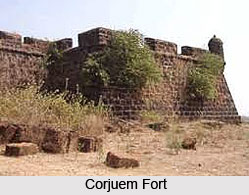 Corjuem Fort also known as Khorguem Fort is an Old Portuguese fort in Corjuem.
Corjuem Fort also known as Khorguem Fort is an Old Portuguese fort in Corjuem.
Location of Corjuem Fort
Corjuem Fort or the Fort of Corjuem which is known as `Forte de Corjuem` in Portuguese language is situated on an island with the same name in Bardez, to the east of the village of Aldona. This fort is separated by the Mapuca River, which is a tributary of the Mandovi.
History of Corjuem Fort
The present Corjuem Fort was built in the year 1705 is made of pitted laterite stones. It is one of the only two inland forts that are presently surviving. The fort was built by the Portuguese in order to protect their territories from mighty rulers like Marathas, Bhonsles and the Rane Rajputs. The original occupiers of Corjuem Fort were the Bhonsles from the Sawantwadi State. Under the Portuguese Viceroy Caetano de Mello e Castro, the control of the fort came under Portuguese India`s administration. The fort was subsequently rebuilt by the Portuguese to boost up defences along Panajim or Panaji, the capital of Goa. In the early 1800s, Corjuem Fort was used as a Military School and had in its defences a battery of four guns. The fortress defended the town of Corjuem and also had a chapel under parochial church of Aldona.
Architecture of Corjuem Fort
The early Corjuem fort was constructed in the year 1551. Corjuem fort is a relatively small fort and is square shaped. The walls of Corjuem fort are wide and have numerous gun ports and murder holes. At each corner of Corjuem fort, there is a ramp like stair that leads to the ramparts. The fort has a well and a three room living quarters. Within the fort is also located a small chapel which seems to be a relatively new addition. This fort protected the Portuguese traders from the Marathas, Bhonsles and the Rane Rajputs in the nineteenth century.
Church in Corjuem fort
The chapel of St. Anthony was earlier known to have been in the Corjuem Fort. The fort has the distinction of being one of the only two inland that are surviving. The fort has become popular for its beauty.
Environment of Corjuem Fort
Corjuem Fort is surrounded by lush greenery and one gets to see the beautiful views of the surroundings. It has become one of the most famous forts of Goa for its rich beauty and history.



















